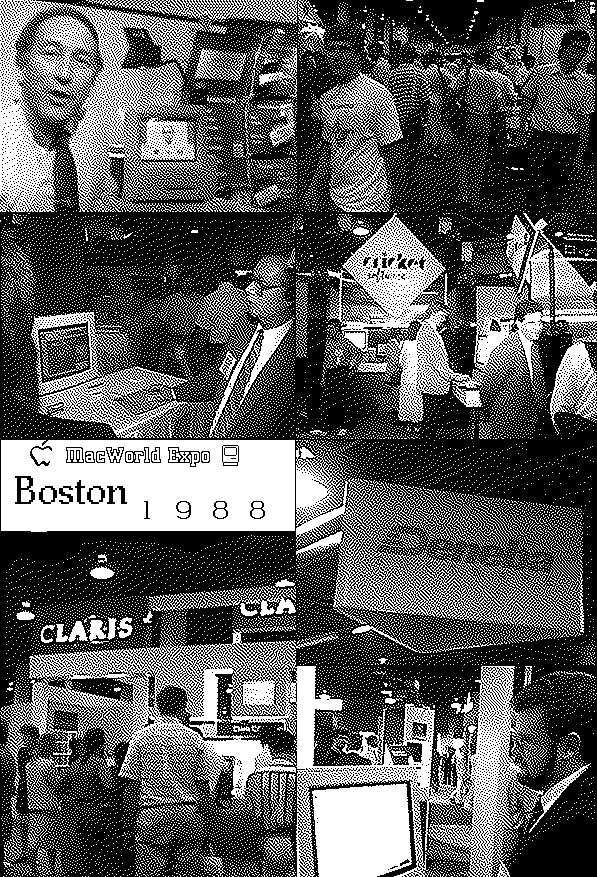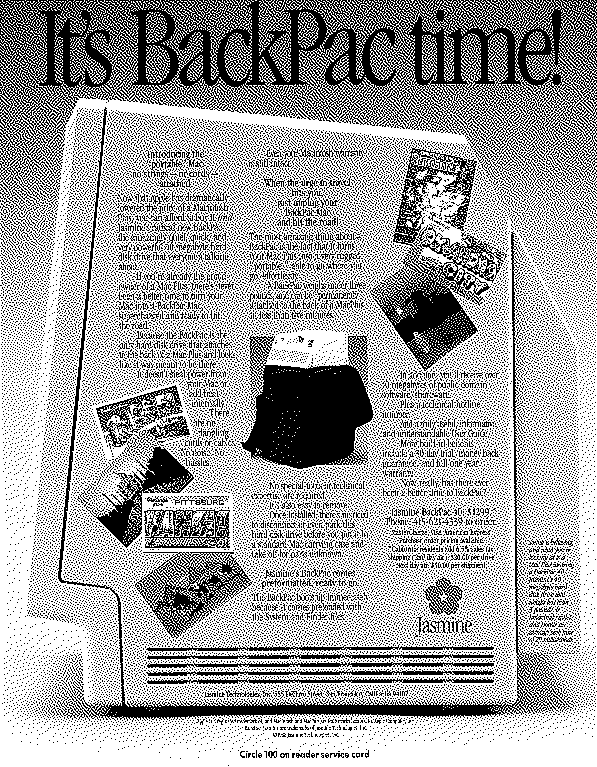 BMUG Meeting minutes 1/21/88
BMUG Meeting minutes 1/21/88
Acta document
BMUG Meeting minutes 1/21/88
Unofficial minutes/notes for the regular weekly BMUG meeting held Thursday, January 21, 1988. Noted by Raines Cohen, in real time. The opinions in here are not necessarily mine or BMUG’s, and all the mistakes aren’t my fault. So there. Call (415) 849-9114 for more information on BMUG meetings.
Announcements
Data Security (?)
MacWorld Expo / San Francisco
45,000 attendance at MacWorld Expo
Thursday (Industry day) – each booth got 10 tickets, but other people got in, too. Much less crowded. Herb Caen mentioned the gridlock caused by the computer show.
The BMUG “Newsletter”
Mailed Tuesday if you didn’t pick it up
“For a user group, you are the most organized…”
Getting there isn’t as easy as it looks…
Carolyn Sagami was the managing editor for this NL
RAM
Dove selling 120 ns RAM the last day of the show
A new company: – 100 ns SIMMS – “P.I.S.” in San Jose. $200. Call BMUG for the #
Ask for Toshiba or NEC 120 ns or better (less), surface-mount SIMMS.
Open Mac Systems (Concord, CA) – sold 150 ns RAM “guaranteed” to run in Mac II – didn’t. We’ve heard complaints about their GenLock system, too – some “experts” claim that their information is incorrect.
GenLock
GenLock is difficult to do and work well.
7 companies at the show, 2 were shipping.
Comtrex – stuff ordered, not shipped?
TrueVision – AT&T people who bought themselves out. $6000, 90 days at least.
“Butterfly” boards that use your present memory (RAM upgrades like Dove MacSnap [some models]) WILL get in the way of SOME expansion or accelerator cards.
Job Opportunities
Someone to network an office with Macs & eventually VAX – SFO
957-9175 Ronya Robbinson.
BMUG looking for office & helpline help
General Parametrics wants QuickDraw & driver programmers. 524-3950 Mike.
LightGate looking for Mac programmer to write ADB drivers for Felix. Oakland, CA.
Apple announced a strategic alliance with DEC.
Sculley was in Boston this week, working out details of DEC’s announcement.
DECNET connectivity & co-development seem to be the main areas of involvement.
University & corporations may “buy in” through this sort of connection
Animation
what do people think about the way they’ve lost certain capabilities with Apple’s upgrades – Color QuickDraw, no page flipping, etc.
Apple’s completely rewriting System from scratch.
Radius product (?): by Andy Hertzfeld: QuickerDraw
rewrote tight loops in the ROMs. Makes color QuickDraw(tm) almost as fast as B&W. Will Apple steal it after it’s released?
Examiner yesterday: “Cultural Clash at MacWorld Expo”. “Andy Hertzfeld meeting John Sculley”: does Apple want to distance itself from the Steve Jobs culture?
Apple to remove ROM code & system baggage to support microsoft products? Rumors on the nets say so.
Apple announced yesterday 1st quarter earnings of $1.042 billion. The stock dropped 3 points. 103% gain in quarterly profits. IBM dropped 9.
InterGraph
?
see Scott Kronick if you can program or if you think you can.
AMUG in Alaska had an editorial – listing all Apple trademarks
SE Silencer literature — where?
M.A.C. in Berkeley – 644-0516 has it.
MacWorld Expo
in Boston – in two places (August)
BaySide Expo & World Trade Center – 5 miles apart
in SFO – FOUR places – Moscone, Brooks, Civic Center, Galeria
HyperAge magazine
about HyperMedia
giving some out tonite
looking for writers & Stack & StackWare(tm) authors*
* StackWare is alleged to be a trademark of Apple Computer, Inc., used to refer to stacks created by Apple.
While we’re at it, Macintosh Today(tm) and MacWorld(tm) are trademarks of Apple, too!
So how does Claris get away with it?
Words starting with “Full-” are claimed to be trademarks of Ann Arbor Software!!!!!
Claris
announced several products at Expo
uses transparent disks
lots of “former” Apple people who used to work in software.
new MacDraw, Paint, Write, Project, forms program (FastForms)
Great party at the Gift Center!
Slick booth
Dark blue suits predominant at booth
Mac II clones
anybody thinking about it?
benefit / detriment to public?
not in this country – who wants to fight Apple’s lawyers?
Read the BMUG NL for info on the patents on “Regions” in QuickDraw.
Get a Magic SAC+ from various stores in Berkeley, “find” Mac 128K ROMs somewhere, and run on an Atari ST.
There are benefits to one-company control of the OS for compatibility, consistency.
Rumors: Tandy, Phoenix working on Mac OS cloning for a while.
If someone could clone a hybrid of the II/SE ROMs…
lots of new HyperCard-related publications
Scott Kronick is writing ABOUT them
We’re working on putting BMUG minutes, disk indices, and BBS stuff in HyperCard stacks – but we need your help to make it happen. Call 549-BMUG.
FullWrite Pro
giving away 2 demo disks
when you print, it says “FullWrite Pro demo version” on each page. No SpellChecker or Thesaurus.
Walking Shadow Press
HyperCard Scripting book for sale tonite
$15.25
by Jeff Stoddard
tutorial
“more detailed than Danny Goodman’s book”
I Don’t recommend “HyperCard Quickly Summarized” (not the exact title)
Next month: UniForum, DEXPO
Sculley is keynote speaker at UniForum
will announce A/UX shipping
will demo Mac-type applications running under UNIX.
AT&T & SUN, IBM & ROLM, DEC & Apple, etc.
“Sort of a triad”
conflicts already – different paths & unstable competition ahead.
Display PostScript(R) – NEXT, DEC, NeWS(tm)…
Show news
yeah. (all but 3 people out of the 300 at tonight’s meeting were AT the show!)
WINGZ(tm)
Excel gone Hyper.
The booth really didn’t show much about it
lots of neat color graphs, even 3-D.
“HyperScripts” is the language – like HT.
LaserWriters
Written on the board last week
Black is black.
Black is $.
$3000 for a non-PostScript low-end machine, all the way up to the IINTX.
Grappler – Orange Micro – Parallel interface
any experience?
for old parallel Dot-Matrix printers.
lets you connect the HP laser, whatnot.
24-pin version not ’til March?
make sure the printer can do reverse line feeds – the ImageWriter sometimes is sent the codes to do that.
Won MacUser’s “parallel printer interface of the year” award
Word and Excel support 3rd-party printers best.
Teaching alternatives besides manuals
videotapes for training –
BMUG’s beginners group – every tuesday, 5-7 PM
Enhanced Beginners group – tues, 7-9 PM
local laser parlors & some colleges & extension programs and computer stores offer for-$ courses
HyperTalk from SAMS – 350 pp., sold by APDA cheap
by Dan Shafer
looks pretty good, more useful than “the bible” for reference and programming
HyperCard 1.1 was announced
it is shipping now
free upgrades will be available at dealers
free upgrades WILL be available at USER GROUPS that license the system software – stay tuned for details.
the upgrades will be available ONLY if you have proof of HyperCard 1.0 ownership – master disk or receipt, probably.
CAD/CAM for digital logic design
Douglas Electronics in San Leandro
see Chad, 4 seats to your left.
analog simulation not yet available
Presentations
FastBack
RasterOps color video
Posted in BMUG Minutes | No Comments »
 MacTurkeyFest 1988
MacTurkeyFest 1988




